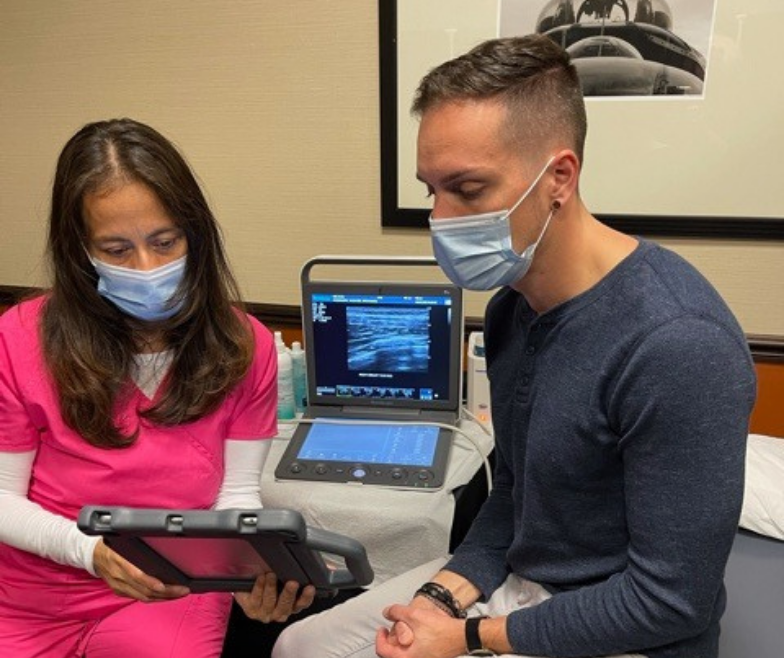Breast Cancer in Men - It’s More Common Than You Think

Did you know that men can develop breast cancer, too? In fact, according to the CDC, approximately 1 in every 100 breast cancers found in the U.S. is found in men. While many people often think that breast cancer is a “woman’s disease”, this is simply not the case.
In the fight against breast cancer, knowledge is power. It’s critical to arm yourself and your loved ones with information regarding the risk factors, symptoms and prevention tips when it comes to breast cancer.
This is especially important information to share with the men in your life as many studies show that men are significantly less likely to seek medical care or go to routine healthcare visits than women. Studies show although men are more likely to have high risk behavior than women, they receive less advice about changing risk factors than women do during checkups. Another recent study that surveyed 1,000 U.S. men ages 18 years and above, found that in the past year, almost half (45%) did not visit a family doctor or general practitioner for an annual wellness visit or checkup.
When it comes to breast cancer, early prevention is everything. Continue reading to discover the facts when it comes to the occurrence of breast cancer in men.
Risk Factors for Developing Breast Cancer
While some risk factors for developing breast cancer are not in our control, some are. Risk factors for developing breast cancer include:
- Aging: The risk of developing breast cancer increases as we age.
- Family history of breast cancer: 1 in 5 men who develop breast cancer have a family member who had breast cancer.
- Inherited gene mutations: The BRCA2 gene increases the lifetime risk of about 6 in 100.
- Radiation exposure: Men who have undergone radiation therapy for cancer in the chest may have an increased risk.
- Obesity: Obese men have higher estrogen levels in their bodies which contribute to the development of breast cancer.
- Alcohol use: Liver disease causes an imbalance to occur in male hormones which play a factor in increasing the risk of male breast cancer.
Symptoms of Breast Cancer in Men
As always, it is critical to report any changes to your physical changes you may experience to your medical provider, even if they seem arbitrary. Symptoms of breast cancer in men vary, but can include:
- A lump or swelling in the breast area
- Pucking or dimpling of the skin
- Redness or scaling
- Discharge
Symptoms of breast cancer are often painless.
Common Types of Breast Cancer in Men
Women and men both share the same common types of breast cancer, which include:
- Invasive ductal carcinoma is the most common type of breast cancer in men. Invasive ductal carcinoma begins to develop in the milk ducts and spreads to nearby breast tissue.
- Ductual carcinoma (non-invasive or pre-invasive breast cancer) accounts for approximately 1 in 10 cases of breast cancer in men and is not always curable with surgery. This cancer occurs when the cells that are near the duct begin to look like cancer cells but have not spread through the walls of the ducts into surrounding breast tissue.
- Invasive lobular carcinoma is a very rare type of cancer that does not develop into invasive cancer if left untreated. This type of cancer leads to an increased risk of invasive cancer in the breasts.
Breast Ultrasound Screening for Men
Because mammograms are not routinely offered to men and may be difficult to perform if there is a small amount of breast tissue present, you may need to be proactive when it comes to screening for breast cancer in men. A Breast Ultrasound Screening offers invaluable insight into breast health. Also, you’ll be happy to know that breast ultrasound screening is completely painless and compression-free.
Breast ultrasound imaging uses the power of sound waves to see inside the breast to detect abnormalities and masses. In addition, breast ultrasound imaging detects blood flow throughout the breasts. To see inside the body, a wand-like probe glides over both breasts and the axilla (armpit) area in a repeated motion. A warm gel is applied to this area and then it is ready to be probed by the transducer. This device is responsible for sending high-frequency sound waves through the breast tissue. The sound waves bounce back and forth through the body, creating an echo. The echo waves are then measured, producing the imaging that is viewed on a computer screen. A Radiologist interprets the internal structures of the breast and then determines the results after the screening is complete.
HerScan is on a mission to make Breast Ultrasound Screening more accessible to all - men included! Put your loved ones first by scheduling them a Breast Ultrasound Screening appointment just for them or have them join you during your next appointment. Appointments are convenient and quick, lasting about 20 minutes.
Schedule an appointment for you and your loved one today! For more information on HerScan and to request an appointment, please click here.
